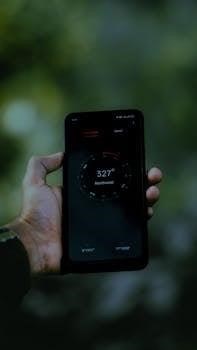Phone wiring‚ while seemingly simple‚ involves understanding basic concepts crucial for reliable communication. This guide explores the fundamentals‚ including wire types‚ connections‚ and essential components. Familiarizing oneself with these aspects is beneficial for troubleshooting issues or making simple installations.
Understanding Basic Phone Wiring Concepts
At its core‚ phone wiring revolves around transmitting audio signals through copper wires. The standard system uses twisted pairs of wires‚ typically two or four‚ to carry these signals. These pairs are often color-coded‚ making it easier to identify and connect them correctly‚ where the first line usually uses red and green wires. A crucial concept is the distinction between tip and ring wires within each pair‚ representing the positive and negative sides of the signal. Residential setups generally use a single pair for one phone line‚ while commercial or multi-line systems utilize multiple pairs. Understanding the basics of polarity‚ where the tip and ring wires must be connected correctly to avoid issues is important. The network interface device (NID) serves as the demarcation point between the phone company’s wiring and your internal wiring‚ and it’s also a key part of these basic concepts. Finally‚ the basic wiring knowledge also includes understanding connectors and the importance of secure connections.

Types of Phone Wiring Diagrams
Phone wiring diagrams vary depending on the application. Common types include standard‚ residential‚ and commercial. Each serves a distinct purpose and offers different levels of detail for specific needs.
Standard Phone Wiring Diagrams
Standard phone wiring diagrams represent the most basic layout of a telephone system. They illustrate the fundamental connections between different components‚ such as the phone line‚ the jack‚ and the handset. These diagrams often use color-coded wires to show how each wire is assigned a specific function‚ like audio transmission or power supply. These diagrams are essential for understanding the underlying principles of phone wiring and serve as a foundation for more complex wiring setups. Standard diagrams typically depict a single line configuration‚ showing how two wires‚ often red and green‚ are utilized for a single telephone line. These are most helpful when learning the general principles of wiring before delving into more specific applications. These diagrams are helpful for basic troubleshooting because they show the minimal requirements for a functioning phone line.
Residential Phone Wiring Diagrams
Residential phone wiring diagrams detail the specific configurations used in homes. They often show how multiple phone jacks are connected to a central point‚ typically the network interface device (NID). These diagrams may include details for single or dual-line setups‚ illustrating how multiple phone lines are distributed throughout a house. They are more comprehensive than standard diagrams and include considerations for multiple phones and extensions. Residential diagrams help homeowners install new phone jacks or troubleshoot issues within their home wiring system. They commonly show how the wires from the NID are connected to various phone outlets and may feature color-coded wiring schemes to aid in proper connections. These are very useful when adding new phone jacks to a pre-existing system‚ while also aiding in basic troubleshooting.
Commercial Phone Wiring Diagrams
Commercial phone wiring diagrams are more complex‚ reflecting the intricate needs of business environments. These diagrams illustrate how multiple phone lines and extensions are routed through a building‚ often involving private branch exchange (PBX) systems. They provide detailed layouts of wiring closets‚ distribution frames‚ and how various phone systems are interconnected. Commercial diagrams often include specifications for digital or VoIP phone systems‚ along with traditional analog lines. They are essential for technicians installing‚ maintaining‚ and troubleshooting office phone networks. Furthermore‚ commercial diagrams are crucial for ensuring all phones in a business environment are correctly connected and communicating effectively. These diagrams must also take into account the possibility of multiple phone lines and their proper distribution. These diagrams are much more complex and require professional expertise.

Key Components in Phone Wiring
Understanding phone wiring involves knowing key components like RJ-11 connectors‚ the network interface device (NID)‚ and master and secondary sockets. These elements play crucial roles in the functioning of a phone system.
RJ-11 Connector and Pin Usage
The RJ-11 connector is a staple in telephone wiring‚ typically featuring six terminals though commonly only the middle four pins are actively used. In standard setups‚ the center pins‚ usually designated as red and green‚ form the primary pair for a single telephone line‚ handling the tip and ring signals. These connections facilitate voice transmission‚ where the tip wire carries the positive voltage and the ring wire completes the circuit. While the outer pins in an RJ-11 connector could potentially support an additional line‚ many residential systems primarily utilize just the central pair. It’s important to note that variations might exist‚ and always consult a specific wiring diagram for accuracy. When wiring‚ ensure correct pin placement to avoid signal interference and maintain clear communication. The RJ-11‚ although simple in appearance‚ is a crucial component for a stable telephone connection.
Network Interface Device (NID)
The Network Interface Device‚ often referred to as the NID‚ is a critical junction point where external telephone lines from the service provider transition to your home’s internal wiring. This box usually contains a customer access compartment‚ allowing homeowners limited access for testing or connection purposes. Inside the NID‚ you will find modular plugs and screw terminals designed to facilitate secure connections. The incoming lines from the telephone company terminate here‚ and then these lines connect to the wires that run into the home. While it might appear complex‚ remember that you have every right to access and inspect it. Understanding the NID is essential for troubleshooting because it serves as the demarcation point between your responsibility and the phone company’s. It is an essential component for any landline phone system and serves as a protected entry point for your phone lines.
Master Socket and Secondary Sockets
The master socket is the primary connection point for your telephone line within your home‚ often containing a capacitor‚ typically 1.8µF‚ for specific line functionalities. It serves as the initial distribution hub for the phone signal. From the master socket‚ secondary sockets are wired to extend phone service to other locations in the house. The wiring from the master to these secondary sockets generally follows a standard color code‚ although variations might exist in older installations. The master socket’s wiring is crucial for ensuring a consistent and clear signal to all connected devices. Secondary sockets‚ then‚ act as extensions‚ allowing multiple phones to function off the same line. It’s important to understand the layout to troubleshoot potential problems. Each secondary socket connects back to the master‚ forming a daisy-chain connection of phone lines throughout the home.

Practical Aspects of Phone Wiring
Working with phone wiring requires careful attention to detail. This section covers key techniques like correctly wiring a phone jack‚ understanding color codes‚ and safely stripping wires to avoid damage.
Wiring a Phone Jack
Wiring a phone jack‚ while not overly complex‚ requires careful attention to detail. Begin by disconnecting the main phone line at the source‚ usually near the electrical panel‚ to ensure safety. The incoming line typically enters a small box with an incoming and outgoing phone line. Before beginning‚ strip about two inches of the outer sheath from the cable‚ being cautious not to nick the internal wires‚ as this can cause shorts. Fan the wires out to prepare them for placement. Usually‚ only the middle four pins of the RJ-11 connector are used. For a single line‚ connect the red and green wires to the corresponding terminals on the jack‚ ensuring a secure fit. The red and green wires contain the first telephone line and are usually the center pins on the connector. Following a telephone wiring diagram can greatly aid in completing this process correctly‚ and can help save money by avoiding professional installation costs. Remember that proper connection of the wires to the correct terminals ensures a stable phone line connection.
Color Codes in Phone Wiring
Understanding color codes in phone wiring is essential for proper installation and troubleshooting. Standard phone wiring typically utilizes color-coded wires‚ each designated for a specific purpose. The most common color pairing involves red and green wires‚ representing the first phone line‚ with the red wire often being the tip and the green being the ring. However‚ there is a possibility of two color codes that you may find in your home‚ and sometimes the colors might vary‚ especially in older installations or business setups. Other colors such as black‚ yellow‚ and sometimes blue and white‚ are used for the second line and other purposes‚ and can be found in 2‚ 3 or 4 pair cables‚ consisting of 4‚ 6 or 8 conductors respectively. These wires should be connected carefully to their corresponding terminals on the jack. A correct wiring diagram can make identifying which wire goes to which terminal much simpler. Consistency in following color codes helps avoid confusion‚ and ensures reliable communication.
Stripping Wires and Avoiding Damage
Stripping wires correctly is a critical step in phone wiring; improper stripping can lead to damage and signal issues. When preparing phone wires‚ it is essential to carefully remove the outer sheath‚ usually about two inches‚ using wire strippers. The internal paired wires should be handled with extreme care to avoid nicking or cutting them. Nicks can lead to weakened wires‚ causing breaks or short circuits down the line. After stripping the outer sheath‚ fan the wires out to prepare for placing them in the correct positions on the terminal. Stripping tools with adjustable guides are helpful to avoid going too deep and potentially harming the internal conductor. Additionally‚ avoid bending the wires too much as repeated bending can cause fatigue in the wire and also lead to breaks‚ and always double check the connection and wiring after it has been completed. Careful wire stripping is important for maintaining the integrity of your phone system.

Troubleshooting and Additional Information
This section covers identifying common phone line problems‚ testing methods‚ and basic repairs. We also provide resources for finding phone wiring diagrams and offer general information to assist you further.
Identifying Phone Line Issues
Troubleshooting phone line problems often starts with recognizing the symptoms. A completely dead line‚ where you hear no dial tone‚ could indicate a break in the wiring or an issue with the network interface device (NID). Static or crackling noises during calls might point to loose connections or damaged wires within your home’s wiring. Intermittent service interruptions suggest fluctuating line conditions or potential wiring faults. If only some phones in your home are affected‚ the problem likely resides in the internal wiring. Check the color-coded wires of each jack for loose connections and proper placement. If you have recently done any work on your electrical panel‚ also check for any disturbances to the phone line. External factors‚ like weather‚ can also affect your phone line. Keep a record of when issues occur to identify any patterns. If issues persist despite your initial troubleshooting‚ consider consulting a professional.
Testing and Repairs
After identifying a potential phone line issue‚ testing and repairs become crucial. Begin by using a known working phone to isolate whether the problem is with your phone or the line itself. If the issue persists‚ check the network interface device (NID)‚ which is the point where the phone line enters your house. Use a multimeter to test the voltage across the terminals. A reading outside of the typical range might indicate a problem with the phone company’s line. If all seems okay there‚ proceed to check your interior wiring. Look for any loose connections at each phone jack and any damaged or corroded wires. If you find a problem‚ make sure to disconnect the main phone line before attempting any repairs. Use wire strippers to prepare the wires for re-connection and make sure they are securely fastened. After making any repairs‚ test the line again. If issues persist‚ it may be time to call a professional.
Resources for Phone Wiring Diagrams
Finding reliable phone wiring diagrams is crucial for accurate installation and troubleshooting. Numerous resources are available‚ both online and offline‚ offering a variety of diagrams to suit different needs. Websites dedicated to electrical wiring often contain sections on telephone wiring‚ presenting standard‚ residential‚ and commercial diagrams. Search for terms like ‘phone wiring diagram’‚ ‘RJ11 wiring’‚ or ‘telephone jack wiring’ to locate these resources. Additionally‚ specialized forums for telephony enthusiasts may offer detailed diagrams and advice from experienced users. Manufacturers of phone jacks and wiring components sometimes provide diagrams in their product manuals or on their websites. Consider also checking libraries and technical bookstores for manuals and guides that include comprehensive wiring diagrams. Remember to verify the accuracy of any diagram you find‚ paying attention to the color codes and pin configurations. Always prioritize diagrams from reputable sources to ensure safety and effectiveness. Utilizing a combination of these resources will provide a thorough understanding of phone wiring.
